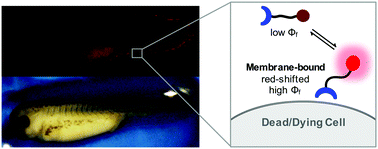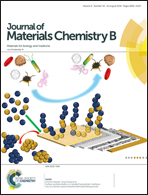Time-lapse imaging of cell death in cell culture and whole living organisms using turn-on deep-red fluorescent probes†
Abstract
Cell death is a central process in developmental biology and also an important indicator of disease status and treatment efficacy. Two related fluorescent probes are described that are molecular conjugates of one or two zinc dipicolylamine (ZnDPA) coordination complexes with an appended solvatochromic benzothiazolium squaraine dye. The probes were designed to target the anionic phospholipid, phosphatidylserine (PS), that is exposed on the surface of dead and dying cells. A series of spectrometric and microscopy studies using liposomes and red blood cell ghosts as models showed that the probe with two ZnDPA targeting units produced higher affinity, stronger fluorescence “turn-on” effect, and better image contrast than the probe with one ZnDPA. Both fluorescent probes enabled “no-wash” time-lapse microscopic imaging of mammalian cell death within a culture. The probe with two ZnDPA units was used for non-invasive time-lapse imaging of cell death during the development of Xenopus laevis (frog) embryos. In vivo fluorescence micrographs revealed probe accumulation within the embryo tail, head and spine regions that were undergoing regression and apoptosis during growth and maturation. These new fluorescent probes are likely to be useful for time-resolved, non-invasive in vivo imaging of cell death process in range of living organisms. From a broader perspective, it should be possible to utilize the negative solvatochromism exhibited by benzothiazolium squaraine dyes for development of various “turn-on” deep-red fluorescent probes and materials that target cell surface biomarkers for in vitro and in vivo imaging.



 Please wait while we load your content...
Please wait while we load your content...